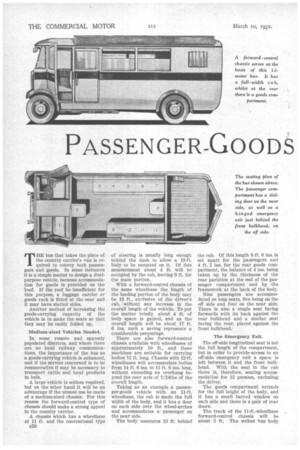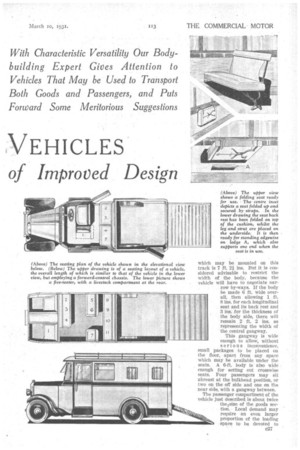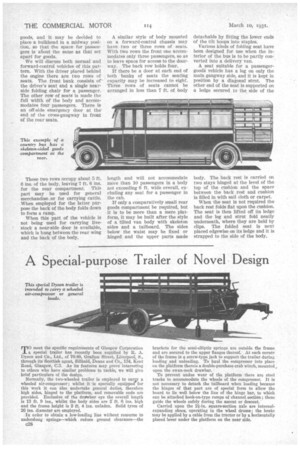PASSENGER-GOODS VEHICLES
Page 48

Page 49

Page 50

If you've noticed an error in this article please click here to report it so we can fix it.
of Improved Design
THE bus that takes the place of the country carrier's van is required to convey both passengers and goods. In some instances it is a simple matter to design a dualpurpose vehicle, because accommodation for goods is provided on the roof. If the roof be insufficient for this purpose, a luggage carrier or goods rack is fitted at the rear and it may have slatted sides.
Another method of increasing the goods-carrying capacity of the vehicle is to make the seats so that they may be easily folded up, Medium-sized Vehicles Needed.
In some remote and sparsely populated districts, and where there are no local railway communications, the importance of the bus as a goods-carrying vehicle is enhanced, and if the service concerned is to be remunerative it may be necessary to transport cattle and local products in bulk.
A large vehicle is seldom required, but on the other hand it will be an advantage if the utmost use be made of a medium-sized chassis. For this reason the forward-control type of chassis should make a strong appeal to the country carrier.
A chassis which has a wheelbase of 11 ft. and the conventional type c26
of steering is usually long enough behind the dash to allow a 13-ft. body to be mounted on it. Of this measurement about 4 ft. will be occupied by the cab, leaving 9 ft. for the main portion.
With a forward-control chassis of the same wheelbase the length of the loading portion of the body may be 13 ft., exclusive of the driver's cab, without any increase in the overall length of the vehicle. To put the matter briefly, about 4 ft. of body space is gained, and as the overall length will be about 17 ft. 6 ins, such a saving represents a considerable percentage.
There are also forward-control chassis available with wheelbases of approximately 10 ft., and these machines are suitable for carrying bodies 12 ft. long. Chassis with 12-ft. wheelbases will accommodate bodies from 14 ft. 6 ins. to 15 ft. 6 ins, long, without exceeding an overhang beyond the rear axle of 7/24ths of the overall length.
Taking as an example a passenger-goods vehicle with an 11-ft. wheelbase, the cab is made the full width of the body, and it has a door on each side over the wheel-arches and accommodates a' passenger on the near side.
The body measures 13 ft: behind the cab. Of this length 8 ft. 6 ins. is set apart for the passengers and 4 ft. 2 ins, for the rear goods compartment, the balance of 4 ins, being taken up by the thickness of the rear partition at the end of the passenger compartment and by -the framework at the back of the body.
Nine passengers are accommodated on long seats, five being on the off side and four on the near side. There is also a single seat facing forwards with its back against the rear bulkhead and a similar seat facing the rear, placed against the front bulkhead.
The Emergency Exit.
The off-side longitudinal seat is not the full length of the compartment, but in order to provide.access to an off-side emergency exit a space is left between it and the front bulkhead. With the seat in the cab there is, therefore, seating accommodation for 12 persons, excluding the driver.
The goods compartment extends for the full height of the body, and It has a small barred window on each side and there is a pair of rear
doors.
The track of the 11-ft.-wheelbase forward-control chassis will be about 5 ft., The widest bus body
(Above) The upper view shows a folding seat ready for use.. The centre inset depicts a seat folded up and secured by straps. In the lower drawing the seat back rest has been folded on top of the cushion, whilst the leg and strut are placed on the underside. It is then ready for standing edgewise on ledge A, which also supports one end when the seat is in use.
which may be mounted on this track is 7 ft. 2i ins. But it is considered advisable to restrict the width of the body,because the vehicle will have to negotiate narrow by-ways. If the body be made 6 ft. wide overall, .then allowing 1 ft. 8 ins. for each longitudinal seat and its back rest and 3 ins. for the thickness of the body side, there will remain 2 ft. 2 ins, as representing the width of the central gangway.
This gangway is wide enough to allow, without serious inconvenience, small packages to be placed on the floor, apart from any space which may be available under the seats. A 6-ft. body Ls' also wide enough for' setting out crosswise seats. Four passengers may sit abreast at the bulkhead position, or two on the off side and one on the near side, with a gangway between.
The passenger compartment of the vehicle just described is about twice thelsize of the goods section. Local demand may require an even larger proportion of the loading space to be devoted to
goods, and it may be decided to place a bulkhead in a midway position, so that the space for passengers is aout the same as that set apart for goods.
We will discuss both normal and forward-control vehicles of this pattern. With the driver placed behind the engine there are two rows of Seats; The front bank consists of the driver's seat and a single nearside folding chair for a passenger. The other row of seats is made the full width of the body and accommodates four passengers. There is an off-side emergency door at the end of the cross-gangway in front of the rear seats.
These two rows occupy about 5 ft. (3 ins. of the body, leaving 7 ft. 6 ins. for the rear compartment. This part may be used for general merchandise or for carrying cattle. When employed for the latter purpose the back of the body folds down to form a ramp.
When this part of the vehicle is not being used for carrying livestock a near-side door is available, which is hung between the rear wing and the back of the body. A similar style of body mounted on a forward-control chassis may have two or three rows of seats. With two rows the front one accommodates only three passengers, so as to leave space for access to the doorway. The back row holds four.
If there be a door at each end of both banks of seats the seating capacity may be increased to eight. Three rows of seats cannot be arranged in less than 7 ft. of body length and will not accommodate more than 10 passengers in a body not exceeding 6 ft. wide overall, excluding any seat for a passenger in the cab.
If only a comparatively small rear goods compartment be required, but it is to be more than a mere platform, it may be built after the style of a tilted van body with skeleton sides and a tailboard. The sides below the waist may be fixed or hinged and the upper parts made detachable by fitting the lower ends of the tilt hoops into staples.
Various kinds of folding seat have been designed for use when the interior of the bus is to be partly converted into a delivery van.
A. seat suitable for a passengergood1ivehicle has a leg on only the main gangway side, and it is kept in position by a diagona/ strut. The other end of the seat is supported on a ledge secured to the side of the
body. The back rest is carried on two stays hinged at the level of the top of the cushion and the space between the back rest and cushion is filled in with sail cloth or carpet.
When the seat is not required the back rest folds flat upon the cushion. The seat is then lifted off its ledge and the leg and strut fold neatly underneath, where they are held by clips. The folded seat is next placed edgewise on its ledge and it is strapped to the side of the body.












































































































